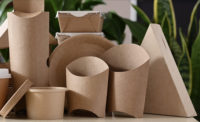Editor’s Note
March Springs Eternal
Just as basketball fans await the fates of their favorite college teams during March Madness, eco-conscious consumers are looking forward to continued innovations in the arena of foodservice packaging.

Courtesy of University of Kansas and Gonzaga University
As a native of northeast Kansas, you can imagine my elation when the Kansas City Chiefs pulled off that nail-biter of a win in this year’s Super Bowl.
Flipping the calendar to a new month, I now look forward to March Madness, for multiple reasons.
As a University of Kansas alum, it’s no surprise that I have something to look forward to every March. I actually had season tickets to KU basketball games when Danny Manning and Larry Brown led KU to the NCAA men’s basketball championship in 1988 (dating myself here). I also enjoyed watching Kansas pull off championship wins over North Carolina in 2022 and over Memphis in 2008.
In 2002, my wife’s career brought our family to Spokane, Washington — home of the Gonzaga Bulldogs, who have their own illustrious record in NCAA basketball history. They have made 24 NCAA tournament appearances, and the Bulldogs have made it to the Final Four twice.
So when March Madness rolls around each year, I have two teams to root for: KU and Gonzaga (KU first, of course).
Just as intriguing as the statistics behind KU’s and Gonzaga’s storied basketball successes are the statistics behind foodservice carry-out, which is the focus of one of this month’s feature stories as it relates to packaging.
As Wall Street Journal reporter Heather Haddon pointed out in a story earlier this year, America’s biggest restaurant companies made a bet during the COVID-19 pandemic that consumers would rather eat the food cooked on their premises someplace else. Now those companies are gambling that customers will want to do so for years to come.
Haddon notes that Starbucks Corp., which long described itself as a “third place” for customers to gather after home and work, plans to add nearly 400 U.S. stores with only delivery or pickup service in the next three years. In its quarter ending Oct. 2, 72% of its U.S. sales were taken to go.
McDonald’s, like many other fast-food chains, weathered the early days of the pandemic better than many sit-down restaurants due to its large number of drive-through lanes. Nearly 95% of its 13,435 U.S. locations have them.
Drive-through service accounted for as much as 90% of the company’s U.S. business in 2020, up from roughly two-thirds before the pandemic.
McDonald’s Chief Executive Chris Kempczinski said in an interview in January that new store formats, including ones without dining rooms, will play a role as the company seeks to add new restaurants in coming years.
Given take-out’s current status as the rising star in foodservice – and with a growing number of consumers concerned about the sustainability of packaging — companies like Kari-Out and Eco-Products seeking to make advancements on this front will be getting more and more attention.
Here’s to their success — and to the success of KU and Gonzaga. Go, Hawks and Bulldogs!
Brad Addington
Chief Editor, Packaging Strategies
(248) 227-4727
addingtonb@bnpmedia.com
Looking for a reprint of this article?
From high-res PDFs to custom plaques, order your copy today!






